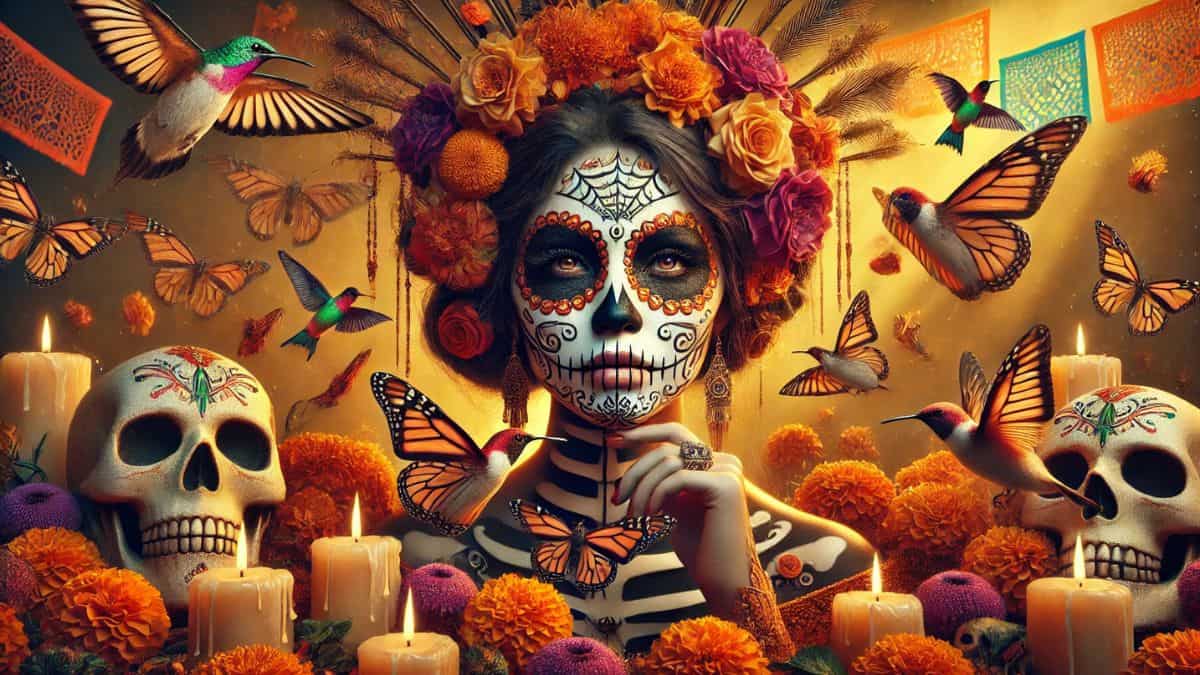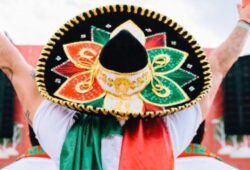
The Day of the Dead or Dia de los Muertos is one of the most significant and colorful traditions in Mexico, around which there are several legends and myths.
Originally, the celebration took place on November 1st and 2nd; however, in recent years, it has extended over several days. During this time, Mexicans honor the memory of their deceased loved ones by setting up altars filled with offerings, flowers, and candles.
This festival, declared an Oral and Intangible Heritage of Humanity by UNESCO in 2003, is surrounded by beliefs and myths that have been passed down from generation to generation.
Here are some legends associated with the Day of the Dead:
What legends exist about the Day of the Dead? The dog on the altar
One of the most curious and lesser-known elements of the altars is the importance of the dog.
According to the mythology of ancient Mexicans, especially the Mexicas, dogs—or xolos—play a fundamental role in the journey to Mictlán, the underworld.
The Mexicas believed that when a person died, their soul embarked on a long and difficult journey to reach eternal rest, and a dog of the xoloitzcuintle breed was responsible for guiding them through rivers and mountains.
The legend says that those who treated dogs well in life could count on their help in the afterlife. However, if they mistreated them, the dog would refuse to help, leaving them lost. For this reason, in some regions of Mexico, a figure of a dog is placed on the altar as a reminder of its protective and guiding role for the deceased.
ALSO READ. Dia de los Muertos for pets: When do dogs arrive at the altar?
The legend of La Llorona
Among the most well-known and terrifying legends in Mexican folklore is the tale of La Llorona. It is said that she is the ghost of a woman who cries inconsolably for the loss of her children.
According to legend, La Llorona lost her children in a tragic accident, and since then, she wanders by rivers and lakes, desperately searching for them.
Some say that hearing her cry is a bad omen, while others believe she acts as a messenger between the world of the living and the dead.
On the Day of the Dead, it is said that her presence marks the path the souls must follow to reach their eternal rest. While her story frightens many, it also carries an important message: La Llorona cries for all the families who miss their loved ones, easing their pain.
ALSO READ. Día de los Muertos: Where did Day of the Dead originate?
The legend of the wooden horses of Cuanajo
In the town of Cuanajo, Michoacán, there is a legend about what happens every November 2nd during the Day of the Dead celebrations. The story tells that the souls of the deceased return to visit their loved ones, riding wooden horses filled with fruits, flowers, and offerings.
Families prepare altars and leave wooden horses on the graves of their loved ones so they can take them back to the underworld. The souls that receive more horses and offerings are those who are remembered and cherished by their families. In contrast, those souls who are no longer remembered pick up what others drop along the way, doing so with sadness because their families have forgotten them.
This legend reminds us of the importance of not forgetting our loved ones, even after they have passed. By remembering their lives with love and gratitude, we ensure that their souls continue to be a part of our lives.
ALSO READ. Day of Dead: 10 facts about Dia de los Muertos
The legend of the fox as a messenger of death
In some regions of Mexico, it is said that the fox is a messenger announcing someone’s death. The legend, originating in Pozo de Acuña, San Luis Potosí, tells that whenever a fox sings at sunset, it is a sign that someone will soon die. It doesn’t matter whether the person lives in the village or far away; the fox’s song is an inevitable announcement.
Many villagers, upon hearing the fox’s song, prepare to say goodbye to a loved one or to receive news of someone’s passing.
The legend of the fox teaches us to always be prepared for the unexpected and to cherish the time we have with our loved ones, as death can come at any moment.
The legend of the marigold flower (cempasuchil)
One of the most important flowers in the Dia de los Muertos celebration is the marigold (cempasuchil), a yellow and orange flower that adorns altars and guides the souls to the offerings. The legend of the marigold tells the story of Xóchitl, a young woman who lived in a valley and was loved by the Sun god, Tonatiuh.
Tonatiuh, who watched her from the sky every day, decided to take human form to approach Xóchitl. The two fell in love and spent several days together. However, Xóchitl, curious to learn more about her lover, followed him one night and discovered he was the Sun god. Frightened, she fled, tripping and falling into a ravine where she died. Upon discovering her body, Tonatiuh, saddened by her loss, transformed her into a flower with golden petals so that he could continue to see her every day from the sky.
The monarch butterflies and the Day of the Dead
Every year, between late October and early November, monarch butterflies arrive in Mexican forests, covering the trees with their distinctive orange and black colors. What makes this event even more special is that it coincides with the Day of the Dead, celebrated on November 1st and 2nd.
The Purépechas, an indigenous people from Michoacán, believe that these butterflies are the souls of the dead who come to visit their families during the Day of the Dead celebrations. For them, the monarchs not only symbolize life after death but also the spiritual connection between the living and the dead, a bond renewed each year with the arrival of these beautiful creatures.
The Aztec legend of the hummingbird and the souls of warriors
In Aztec culture, the hummingbird holds a special meaning. According to legend, warriors who died in battle or were sacrificed to honor the gods did not go to Mictlán like other souls. Instead, their souls turned into hummingbirds and accompanied Huitzilopochtli, the god of war and the sun, on his journey across the sky.
These brave and energetic hummingbirds were considered divine messengers, bringing the spirit of the sun and life to earth. When an Aztec saw a hummingbird, they believed it was a warrior who had given their life and was now blessing and protecting their loved ones.
Hummingbirds are also a symbol of eternal love. Many legends claim that hummingbirds are the souls of lovers who, after death, return to remind us that true love never fades. These small birds, capable of flying forward, backward, and hovering in one place, represent the persistence of love and memory that never vanishes.
It is said that if a hummingbird appears in moments of sorrow or pain, it is the spirit of a loved one coming to comfort you, reminding you that the love you shared remains alive, even beyond death.
TE PUEDE INTERESAR: Adorable perro catrina para tu altar de muertos en Amazon











